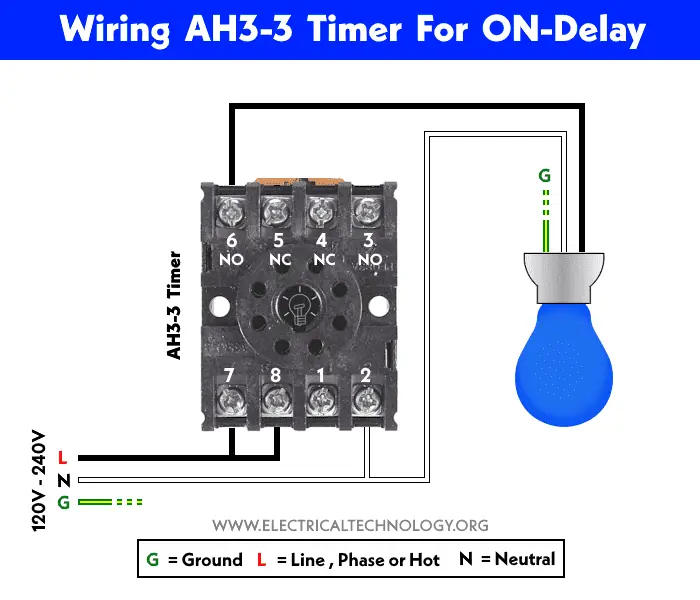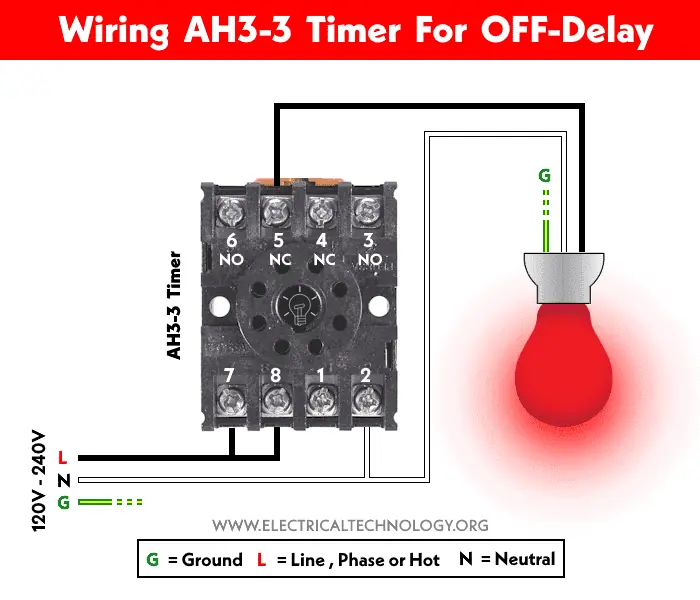Introdução
Os temporizadores de atraso ligado e de atraso desligado são componentes cruciais nos sistemas de controlo, cada um servindo funções distintas com base no seu comportamento de temporização em relação aos sinais de entrada. Enquanto os temporizadores de atraso ligado introduzem um atraso antes de ativar a saída, os temporizadores de atraso desligado mantêm a saída durante um período definido após o sinal de entrada ser removido, oferecendo vantagens únicas para várias aplicações industriais e de automação.
Conhecimentos básicos
Definição e princípio de funcionamento do temporizador de atraso de ativação
Um temporizador de atraso ON, também conhecido como temporizador de atraso ON, introduz uma pausa entre a ativação de um sinal de entrada e a subsequente ativação de um sinal de saída. Quando acionado, o temporizador inicia uma contagem decrescente a partir de uma duração predefinida, durante a qual a saída permanece inativa. Só depois de decorrido este tempo pré-determinado é que o sinal de saída é ativado, o que o torna ideal para aplicações que requerem uma sequência de arranque controlada.
Definição e princípio de funcionamento do temporizador de atraso de desativação
Um temporizador de atraso DESLIGADO mantém o seu sinal de saída durante um período de tempo especificado após a remoção do sinal de entrada. Quando ativado, dispara imediatamente a saída, que permanece ativa durante o período de atraso predefinido após a desativação da entrada. Esta funcionalidade é particularmente útil em aplicações que requerem uma paragem controlada ou um funcionamento prolongado após a remoção do disparo inicial. As utilizações comuns incluem:
Comparação pormenorizada
Diferenças entre o temporizador de atraso de ativação e o temporizador de atraso de desativação
| Recurso | Temporizador de atraso de ativação | Temporizador de atraso DESLIGADO |
|---|---|---|
| Ativação | Atrasa a ativação após o sinal de entrada | Ativa-se imediatamente após o sinal de entrada |
| Desativação | Ativa a saída após o atraso | Mantém a saída durante um atraso após a entrada |
| Casos de utilização típicos | Arranque de motores ou sistemas após a instalação | Permitir que as ventoinhas arrefeçam antes de se desligarem |
Vantagens e desvantagens
- Temporizador de atraso de ativação
- Vantagens: Proporciona um controlo preciso do início dos processos; evita a ativação prematura.
- Desvantagens: Pode introduzir atrasos indesejáveis em operações críticas se não for corretamente definido.
- Temporizador de atraso DESLIGADO
- Vantagens: Garante a conclusão dos processos antes da paragem; útil para sistemas de arrefecimento.
- Desvantagens: Pode levar a tempos de funcionamento prolongados se não for cuidadosamente gerido.
Comparação de cenários de aplicação
- Os temporizadores de atraso ON são normalmente utilizados em aplicações como:
- Sistemas AVAC em que o equipamento não deve arrancar imediatamente.
- Correias transportadoras onde os objectos devem assentar antes do início do movimento.
- Os temporizadores de atraso OFF encontram aplicações em:
- Sistemas de iluminação que necessitam de permanecer ligados durante um curto período de tempo após a saída de uma divisão.
- Motores que necessitam de arrefecimento antes de se desligarem completamente.
Diferenças nas funções de temporização
A distinção fundamental entre temporizadores de atraso ligado e temporizadores de atraso desligado reside nas suas funções de temporização. Os temporizadores de atraso ligado (TON) introduzem um atraso entre a ativação do sinal de entrada e o sinal de saída, mantendo a saída inativa durante um período pré-determinado antes da ativação. Este comportamento é útil para aplicações que requerem uma ativação gradual para evitar choques no sistema ou garantir a estabilidade. Por outro lado, os temporizadores de atraso desligados (TOF) activam a sua saída imediatamente após receberem o sinal de entrada, mas mantêm essa saída durante um período de tempo definido após o sinal de entrada ser desligado. Esta caraterística é particularmente benéfica em cenários em que o equipamento precisa de continuar a funcionar por breves instantes após a desativação, como no arrefecimento de máquinas após a operação.
Comportamento do sinal de saída
O comportamento do sinal de saída dos temporizadores de atraso ligado e desligado difere significativamente. Para temporizadores de atraso ligado, a saída permanece inativa durante o período de atraso e só é activada quando o tempo definido tiver decorrido. Por exemplo, com uma definição de 10 segundos, a saída será activada 10 segundos após a ativação da entrada. Em contraste, os temporizadores de atraso desligados activam a sua saída imediatamente quando o sinal de entrada é recebido. Quando a entrada é removida, a saída permanece ativa durante o atraso especificado antes de se desligar. Este comportamento permite a continuação do funcionamento após a cessação do sinal de entrada, tornando os temporizadores de atraso de desativação ideais para aplicações como manter as luzes de emergência acesas após uma falha de energia ou permitir que as ventoinhas de arrefecimento funcionem após o encerramento da máquina.
Aplicações práticas
Casos de aplicação em controlo industrial
Em ambientes industriais, os temporizadores de atraso ON e OFF são componentes integrais dos circuitos de controlo. Por exemplo:
- Pode ser utilizado um temporizador de atraso de ligação para garantir que um motor não arranca até que todas as verificações de segurança estejam concluídas.
- Um temporizador de atraso DESLIGADO pode ser utilizado numa linha de montagem para manter a maquinaria a funcionar durante um curto período de tempo após a paragem da produção, permitindo a libertação de material.
Exemplos de aplicação na programação de PLC
Nos Controladores Lógicos Programáveis (PLCs), estes temporizadores são implementados como blocos de funções:
- O bloco de funções de atraso de ativação pode ser programado para iniciar operações apenas depois de se verificarem condições específicas.
- O bloco de função de atraso OFF pode ser definido para manter as saídas activas durante um tempo adicional após a conclusão da operação.
Casos de aplicação específicos em diferentes sectores
Várias indústrias utilizam estes temporizadores:
- Fabrico: Para operações sequenciais em que o tempo é crítico.
- AVAC: Para gerir eficazmente o arranque e a paragem do equipamento.
- Processamento de alimentos: Garantir que a maquinaria funciona apenas quando estão reunidas condições de segurança.
Símbolos e métodos de cablagem dos temporizadores
Os temporizadores são representados por símbolos específicos nos esquemas. Os métodos de cablagem variam consoante se trate de dispositivos electromecânicos ou de estado sólido, sendo necessárias ligações claras para um funcionamento adequado.
Método do fio de atraso de ligação

Método do fio de atraso DESLIGADO

Crédito para tecnologia eléctrica
Resolução de problemas e manutenção de temporizadores
A manutenção regular inclui a verificação das ligações, a garantia de que as definições estão corretas e a substituição de componentes defeituosos. A resolução de problemas pode envolver testes com multímetros ou a observação do comportamento operacional em condições controladas.
Selecionar o temporizador certo
Ao escolher entre temporizadores de atraso ligado e desligado, considere os requisitos específicos da aplicação e o comportamento operacional desejado. Os principais factores incluem:
- Necessidades de tempo: Os temporizadores de atraso de ativação são definidos com base no tempo de espera desejado antes da ativação, enquanto os temporizadores de atraso de desativação são configurados para a duração do funcionamento contínuo após a cessação da entrada.
- Caraterísticas de carga: Cargas diferentes podem exigir estratégias de temporização específicas para um funcionamento seguro e eficiente.
- Conceção do circuito de controlo: Assegurar a compatibilidade com as configurações de cablagem e as linguagens de programação dos PLC.
- Condições ambientais: Selecione temporizadores classificados para o ambiente de funcionamento, tendo em conta a tensão, a corrente e os níveis de proteção.
- Ajustabilidade do utilizador: Procure temporizadores com interfaces de fácil utilização para ajustar facilmente a definição do atraso.
FAQ
Quando é que um relé de atraso fornece um atraso de tempo?
Um relé temporizador de desfasamento fornece a sua função de atraso de tempo especificamente quando a tensão de entrada ou o sinal de controlo é removido. Ao contrário dos temporizadores de retardo, que retardam a ativação, os relés de retardo iniciam sua sequência de temporização no momento da desativação. Esta caraterística única torna-os ideais para aplicações que requerem operação contínua após o desligamento de um sistema.
- O atraso começa imediatamente quando a alimentação de entrada é cortada ou o interrutor de controlo é aberto
- A saída permanece activada durante o período de atraso predefinido, permitindo que os dispositivos ligados continuem a funcionar
- Uma vez decorrido o tempo de atraso, os contactos do relé mudam de estado, normalmente abrindo para desligar o circuito
- Se a tensão de entrada for reaplicada durante o período de atraso, a maioria dos temporizadores fora de atraso será reiniciada, reiniciando a sequência de temporização
Este comportamento de temporização é particularmente útil em cenários como o arrefecimento do motor, a iluminação de emergência e os processos de encerramento controlado, em que uma desativação gradual ou retardada é crucial para a segurança ou eficiência operacional.
Como funciona um relé de temporização?
Os relés temporizados funcionam controlando o tempo dos contactos eléctricos, atrasando a sua abertura ou fecho após um evento de disparo específico. No seu núcleo, estes dispositivos são constituídos por um mecanismo de temporização interno e contactos de relé. Quando ativado, o mecanismo de temporização inicia uma contagem decrescente com base num período de atraso pré-programado, que pode variar entre nanossegundos e vários minutos.O processo envolve normalmente:
- Receção de um sinal de entrada (elétrico ou mecânico)
- Ativação do mecanismo de temporização interno
- Contagem decrescente do período de atraso predefinido
- Alteração do estado dos contactos do relé (abertura ou fecho) após o fim do atraso
Os relés de temporização podem ser configurados para várias funções, tais como atraso na ativação (atrasando a ativação após a receção de um sinal) ou atraso na desativação (mantendo a ativação durante um período após a remoção do sinal). Esta versatilidade permite-lhes ser utilizados em inúmeras aplicações, incluindo controlo de motores, sistemas de iluminação, automação industrial e sistemas de segurança, onde a precisão e a fiabilidade são cruciais.
Explorar mais: Guia completo para o relé de temporização
Conclusão
Este artigo explorou os aspectos fundamentais dos temporizadores de atraso ON e OFF, destacando as suas definições, princípios de funcionamento, vantagens, desvantagens e aplicações práticas em vários sectores. À medida que a tecnologia avança, estes temporizadores continuarão a desempenhar um papel essencial no aumento da eficiência e segurança operacionais. Os leitores interessados em aprofundar este tópico podem considerar a possibilidade de consultar guias de fabricantes específicos ou manuais de automação avançada para obterem informações mais aprofundadas.
Explorar mais:


